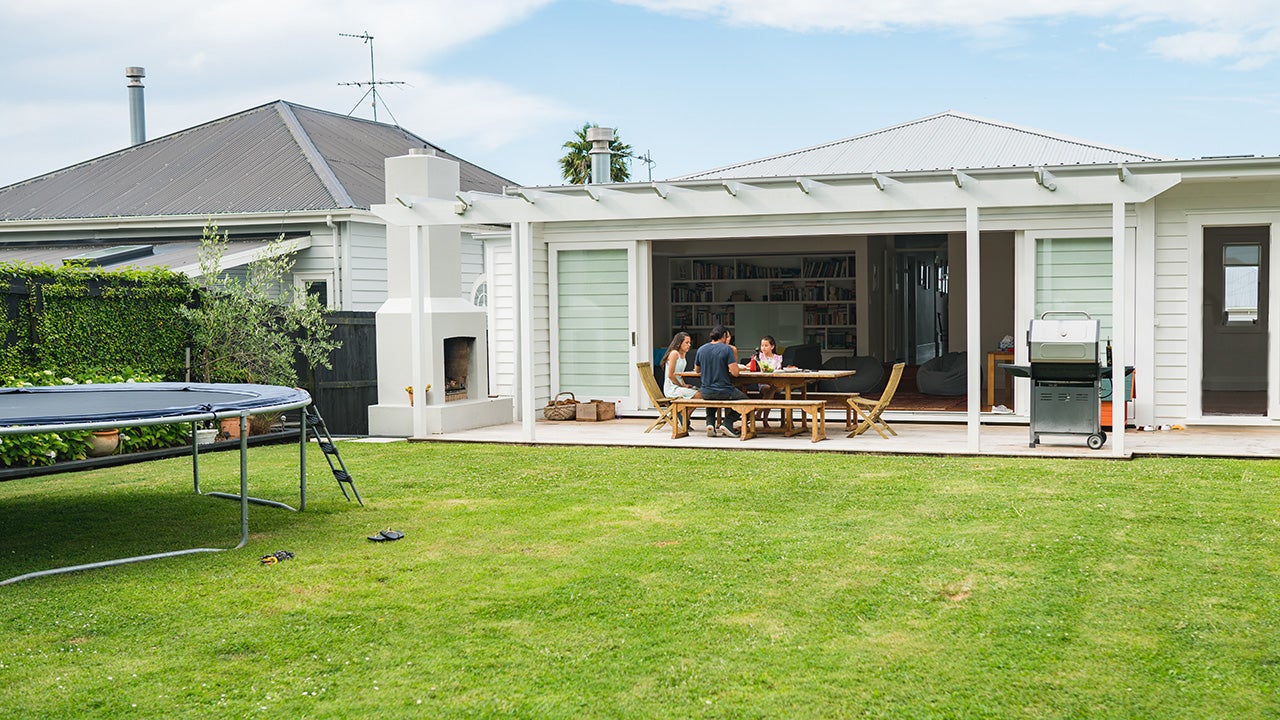How much homeowners insurance do I need?

Key takeaways
- Your home's size, age and features, as well your personal property, impact how much coverage you need.
- Keeping a digital home inventory can help determine appropriate policy limits and make the claims process smoother.
- You may add coverage or endorsements to bolster a standard policy.
Home insurance is meant to help minimize the financial impact of costly, unexpected damage to your home and property. When determining how much home insurance you need, it’s important to know that there are different types of homeowners insurance policies, coverage types and even exclusions to consider before purchasing coverage. Bankrate’s editorial team is here to help you better navigate the home insurance landscape.
How to determine how much homeowners insurance you need
Deciding on the proper amount of coverage for your home insurance policy might seem daunting, but it doesn’t have to be. The coverage types and levels each homeowner needs will vary significantly based on the situation. But generally, home insurance companies have tools that can help, and speaking with an agent can offer peace of mind.
Home insurance calculators estimate the rebuilding cost of your home based on details like its location and size, interior finishes and custom features (if any). Once your dwelling amount — the amount of coverage you’ll need for the structure of your home — is determined, that number will serve as the basis for the levels of several other coverage types.
For example, your personal property coverage is usually set automatically, typically between 50 to 70 percent of your dwelling amount. The same goes for other structures coverage and loss of use coverage. Coverage percentages are generally set automatically based on the amount of dwelling coverage you need. You can usually adjust the policy if you need more coverage, but the automatic levels serve as a starting point.
1. Assess your home
The first step in choosing how much homeowners insurance you need is usually doing a full assessment of your home. Insurance companies have their own metrics for assessing your home’s value and potential risk, but as an owner, it’s generally a good idea to have an overview of your home and what you need covered before shopping around for quotes.
Some standard factors to take into consideration include the size, age and features of your home, as well as the age of your roof. You may also want to do a full assessment of your valuables and who uses your home (factors we will go into in more detail below).
2. Know the difference between actual value and replacement cost
Home insurance policies have a few different ways of compensating you for damage: actual cash value (ACV) and replacement cost value (RCV). You may have the option to choose between these settlement types, or you may automatically be given one or the other. Understanding them is important, though, as it can help you set realistic expectations should you need to file a claim.
Actual cash value means that depreciation will be factored into a claim settlement. For example, if you have ACV coverage for personal property and your 15-year-old television is damaged in a covered loss, your home insurer will pay you the actual value of your television rather than what it would cost to buy a new one.
For more robust coverage, you may be able to choose replacement cost. This settlement type would pay you the cost to replace your television, even though a new TV likely costs more than what your 15-year-old one is worth. Both ACV and RCV can apply to your home’s structure, your personal property or both. If you aren’t sure what coverage is best for you or which settlement option is included in your existing policy, it may be helpful to talk to your agent.
Insurance companies set sub-limits for certain types of personal property. For example, a policy with $100,000 in personal property coverage may only pay a maximum of $2,000 for jewelry losses. If you have expensive personal belongings, you may consider adding valuable items coverage or scheduled personal property coverage.
3. Research local building costs
You purchase homeowners insurance to prepare for damage or loss, so you should know how much it will cost to repair or replace your house. Research how much building supplies and labor will cost to restore your house to its current state or build an equivalent new home. Factors that impact the amount of coverage your house needs include the number of bathrooms it has, materials used in its construction and its special features. For instance, if your living room features imported custom tiling, you might need higher coverage levels to protect it. Understanding these factors could help you decide if a company’s calculation of your home’s replacement value is too high or too low.
One aspect of building costs to consider is whether your home meets current building codes. Typically, homes that are not up to code cost more to rebuild. If your home does not meet current building codes, you may want to consider adding an ordinance or law endorsement to your home insurance policy. Following a covered loss, ordinance or law coverage can help pay for the additional costs of bringing your home up to code.
4. Consider how you use your home
How you use your home can help you determine the amount of personal liability, medical payments and umbrella insurance you may need. For example, if you often host parties or guests, you may want to consider a higher liability limit and possibly even an umbrella policy to protect you in case someone is injured as a result of your negligence. If you have a swing set or pool (especially those with a diving board), you may want to increase your medical payments coverage, which pays for medical costs guests incur up to your policy limit — regardless of fault.
5. Research rental rates in your area
If your home sustains major damage, you could spend weeks or months living in temporary housing while it’s repaired. This is why it may be a good idea to find out how much it will cost for you and your family to rent a home or apartment in your area, or live in a local hotel. Homeowners who live in expensive housing markets, such as San Francisco or New York City, may need more additional living expenses coverage — also called loss of use coverage — than what a standard policy includes.
6. Take stock of your personal belongings
If you need to file a claim for damage to your personal property, a home inventory can be a helpful tool. This includes:
- Name and description of items
- Purchase cost or actual cash value
- Date and place of purchase and receipts, if available
- Photos of each item
- Estimated replacement cost
Having a digital home inventory can also help to make the claim process smoother. The list should have everything that you consider valuable, including electronics, cash, jewelry and furniture. Consider using online cloud storage for your inventory or storing it in another location like your office or a family member’s house. That way, if you do sustain damage to your home, the list will not be damaged as well. You can also ask your home insurer for recommendations of inventory apps to make the process easier.
Determining the value and replacement cost of your belongings takes time and should be given the proper thought. You can replace items such as modern sofas and coffee tables with relative ease, but possessions such as fine art and family heirlooms are often irreplaceable.
Homeowners insurance policies frequently have set limits on the amount of coverage included for individual items such as electronics and artwork. If you own a lot of valuable items, you might consider increasing your policy’s limits or purchasing additional coverage for specific possessions in the form of an endorsement or floater.
7. Factor in your personal finances
Personal finances are a typically key factor in determining how much you can afford to pay out of pocket to rebuild your home or replace personal belongings. Keep in mind that while most homeowners insurance policies include a provision that automatically increases your coverage limits each year to keep up with inflation, if inflation rises rapidly, your current limits may not be sufficient to properly cover you, and you may need to adjust your policy.
Most insurance experts agree that it is best to carry enough coverage to rebuild your dwelling and replace personal items. However, some homeowners have ample savings and may prefer to cover more costs out-of-pocket in case of damage to their home or property in exchange for lower rates on their insurance.
You can typically lower your home insurance rate by increasing your deductible. But be aware that if a disaster strikes, you will have to pay more using your own funds. How much you should insure your home for comes down to risk. If you do not carry enough homeowners coverage, a major loss caused by a fire, storm or other event could severely impact your finances.
8. Consider additional coverage
Even with robust home insurance, like an HO-5 policy, you may still have gaps in your coverage. For added layers of protection, you might want to take a look at the different home insurance endorsements an insurer offers. Endorsements, also called riders or add-ons, are optional additions to your policy that add or extend coverage for certain items or perils.
Endorsements vary among providers; some home insurance providers may offer a broad selection, while others may be more limited when it comes to additional coverage. Additionally, what some insurers offer as an endorsement may be what other insurers include as standard in their policies.
Some popular home insurance endorsements are:
- Service line coverage
- Identity theft coverage
- Inflation guard coverage
- Equipment breakdown coverage
Be sure to read your home insurance policy carefully before you start looking at endorsements. And, keep in mind that policy add-ons will likely increase your premium.
9. Revisit your homeowners policy annually
Personal factors that affect your coverage and premium rates change, so your policy might need to change, too. You may also want to update your inventory of personal belongings, especially if you’ve made big purchases or downsized since you took out the policy. Establishing time for an annual review is a good time to look at any endorsements you’re paying for. If your situation has changed and you no longer need the additional coverage — or if you need new coverage types — you might want to adjust your policy.
What is not covered in a standard homeowners insurance policy?
As a homeowner, several mishaps could impact your house. While home insurance can protect your finances against a variety of situations, a standard policy does not cover everything. In fact, there are several common home insurance exclusions. For the damage not covered by a standard policy, you may want to consider purchasing additional coverage, including:
- Flood insurance: Standard homeowners policies do not include flood coverage. Generally, you will need to purchase a separate flood insurance policy for this coverage. Flood insurance is offered through the National Flood Insurance Program, administered by the Federal Emergency Management Agency, as well as some private insurers.
- Earthquake insurance: Most homeowners insurance policies do not cover damages caused by earthquakes, even in high-risk areas. However, many home insurers offer separate policies or homeowners insurance endorsements for earthquake damage. In California, this coverage is offered through the California Earthquake Authority.
- Sinkhole coverage: Sinkholes occur in many regions of the U.S. but are not covered by a standard homeowners policy. Sinkholes can cause extensive damage to homes, so sinkhole coverage is important to have if your area is prone to this hazard.
- Mine subsidence insurance: In some areas of the country, sinkhole-like damage can be caused when abandoned mines collapse. This is called mine subsidence, and you’ll need an endorsement on your home insurance policy in order for related damage to be covered.
- Umbrella insurance: Umbrella policies may help pay liability claims after your personal liability insurance reaches its limit. For example, if a court awards an injured person $500,000 after sustaining an injury on your property and the liability limit on your home is only $300,000, your umbrella policy could pay the difference up to the umbrella policy limit.
- Sewer backup coverage: Although sewer backup coverage is not part of a standard home insurance policy, it can usually be purchased as an endorsement. Performing preventative checks to protect your house from backed-up pipes may also be helpful.
- Priceless jewelry and antiques coverage: While coverage for valuables like jewelry and art is typically included in a standard homeowners policy, there are usually limits as to what an insurance company will pay out for these items in case of a covered peril. Homeowners with extensive collections of valuables may want to purchase additional add-on coverage to ensure their items are financially protected.
- Aggressive dog breed insurance: Home insurance policies often exclude liability coverage for injuries caused by certain dog breeds, such as pit bulls, German shepherds or Rottweilers. If you have a dog, let your insurance company know. If they exclude coverage for your dog’s breed, it may be prudent to seek out a home insurer that offers coverage.
Frequently asked questions
-
The average cost of homeowners insurance nationwide is $2,150 per year for $300,000 in dwelling coverage as of April 2024, according to Bankrate’s analysis of average rate data from Quadrant Information Services. However, your insurance premium will likely vary depending on a number of factors, like the coverage options you choose, your location and the size and condition of your home. The best way to find the cheapest home insurance may be to shop around and compare quotes from several different companies. When calculating your home insurance costs and reviewing quotes, make sure you are comparing the same coverage amounts and types to determine which company offers the right coverage for your needs at the best price.
-
Most insurance professionals suggest shopping around for new quotes 30 to 60 days before your policy renews. You can do this multiple ways: visiting carrier websites directly, calling an independent agent or contacting an insurance broker. If you are a seasoned homeowner with a solid grasp of what you need from your policy, you may want to shop independently. Or, if you’re a newer homeowner (or need a little extra guidance), then contacting a licensed professional may be a better route.
You’ll need your name, date of birth and possibly your Social Security number, as well as information about your house, including the year it was built and the age of the roof. It may be good practice to compare home insurance quotes from several companies, so you can review each carrier’s rates, coverage choices, discounts and third-party ratings.
-
Yes. Coverage C of your home insurance policy provides financial protection for your personal property. Your personal property could be covered on an open-peril basis or a named-peril basis. This means that your items could be protected from all kinds of losses (except the ones that are excluded from your policy like floods and earthquakes), or only from losses that are specifically listed. Looking at your insurance declarations page can help you better gauge how and when your personal property is covered by your home insurance policy.
-
In most home insurance contracts, your personal property insurance limit (Coverage C) is around 50 percent of your dwelling limit (Coverage A). So, if you have a policy with a $300,000 dwelling limit, you likely have $150,000 for your personal belongings. A home inventory can help you pinpoint whether this amount meets your needs. You’ll also want to consider scheduling valuable items like jewelry and some electronics so they are adequately covered.
-
Hazard insurance usually refers to the part of your home insurance policy that covers your home’s physical structure. The term “hazard insurance” is more commonly used by mortgage companies, rather than insurance professionals. That’s because hazard insurance technically protects your mortgage company’s financial interest in your home (its physical structure), while home insurance mostly protects the homeowner by including personal property coverage, liability insurance and medical payments coverage. If you have a home insurance policy, you already have hazard insurance.
-
It depends. If you have a mortgage on your home, you will likely be required to purchase home insurance as a condition of your loan. If your home is in a FEMA-designated flood zone, you may also be required to carry flood insurance. Even if you own your home outright, having home insurance is a smart way to protect your finances. Think about it this way: it’s usually cheaper to pay a home insurance premium than it is to completely rebuild your home after a disaster.








